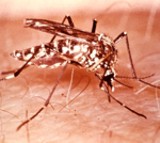The biology of malaria is complicated. It involves understanding the lifecycle of the malaria parasite (plasmoduim) and of the vector (mosquito). This is discussed in detail on the biology pages, but on this page is a simplified version as it is important to understand this biology in order to understand the geography and modelling sections.
Malaria transmission
Malaria is caused by a parasite (Plasmodium) there are several strains of this, some cause malaria in animals and four cause malaria in humans. This parasite can be transmitted to humans in one of three ways:
- Transmission by a vector (being bitten by an infected mosquito);
- Transmission between humans by blood transfusion (receiving blood from an infected human);
- Transmission in the womb (transmission from an infected mother to unborn baby in the blood).
The main form of transmission is number one (by mosquito vector) and this is the form of transmission which has strong climatic links and so is the focus of this section.
In order to understand the effect of climate on malaria, it is important to understand the lifecycle of the parasite and the vector.
Parasite lifecycle
The parasite lifecycle has two stages: one in the human (host) and one in the mosquito (vector).
Host (human)
- The stage in the human begins when an infected mosquito bites a human. The Plasmodium (malaria) parasite passes from the salivary glands of the mosquito into the human.
- The parasite then develops and multiplies in the liver and the red blood cells. Reproduction here is asexual - it is through cell division. This causes the red blood cells to rupture and it is this rupturing that causes the symptoms of malaria and can lead to death.
- The final stage of development in the human is that the parasite cells, which until now have been asexual, develop into male and female forms. Once this has happened the human is infectious.
- If the human is bitten by another mosquito, these male and female forms of the parasite are ingested in the mosquito with the blood.
Vector (mosquito)
- Once the mosquito has ingested the parasite, the parasite lifecycle continues in the mosquito.
- Here the parasite continues to multiply (sexually at this stage), and moves from the stomach to the salivary glands so that if the mosquito bites another human the parasite will be passed into another host.
- This stage is called sporogony.
Temperature dependence
It is the sporogonic stage (development in the mosquito) which is dependent on temperature.
Humans are warm blooded, and so heat needed by the parasite in the host is not dependent on the outside temperature, but once in the mosquito, the energy needed to reproduce is gained from environmental temperature.
The sporogonic cycle is faster at high temperatures. It can occur at lower temperatures but it takes longer.
Mosquito lifecycle and temperature
The lifecycle of the mosquito also depends on temperature. The time it takes to develop from an egg to an adult capable of laying new eggs is longer at lower temperatures.
It is this relationship between the amount of time it takes a mosquito to develop and the amount of time it takes the parasite to develop in the mosquito which results in the temperature dependence of malaria transmission.
The mosquito must survive long enough to ingest the parasite, for the parasite to develop and to bite another human, passing on the parasite.
Female mosquitoes need a blood meal (bite a human or animal) in order to develop the eggs. Only about 50% of mosquitoes survive going for a blood meal (they are swatted or eaten by predators). If the temperature is high and the mosquito cycle is fast, mosquitoes will go for blood meals more frequently and so at high temperatures mosquito survival rates are low.
The graph below sumarises this. It shows the percentage of mosquitoes (vector) which survive long enough for the paraste to develop (sporogony).

As you can see from the graph, below 18oC it is too cold as the sporogonic cycle would last longer than the mosquito would live.
Above 40oC the enough mosquitoes don't survive to develop and pass on the parasite.
The optiimum temperature for malaria transmission is therefore between 28 and 32oC.
Rainfall
It isn't just temperature which controls the transmission of malaria. Rainfall, or water supply is also important.
This is because the mosquitoes lay their eggs in water. They need still water where the eggs are suspended near the water surface and develop.
This doesn't need to be a big body of water. Water which has collected in an old tin can or tyre is sufficient. Enough rainfall is needed though to allow water to build up and not evaporate too quickly.
In some places, rainfall isn't needed as water is available from irrigation or rivers.
This link between water and temperature is therefore important to understand in order to understand the global distribution of malaria.
Other mosquito borne diseases
Mosquitoes are the vector for other important diseases that affect humans as well as malaria. These include:
- the West Nile Virus where the mosquitoes as the vectors include certain Aedes and Culex mosquito species;
- Dengue fever which is a virus spread by certain Aedes spp., particularly the Aedes aegypti mosquito;
- Yellow Fever is a virus spread by certain Aedes spp. mosquito and in urban areas predominately by Aedes aegypti;
- and for Rift Valley Fever the vectors are certain species of Aedes and Culex mosquitoes.

The picture above shows a female Aedes aegypti mosquito. This mosquito is a known transmitter of both Dengue fever, and yellow fever. In fact, A. aegypti is sometimes referred to as the “Yellow Fever Mosquito”. The viruses are transferred to the host when bitten by a female mosquito.
Of course mosquitoes are not the only insect or animal to carry diseases. You may wish to carry out your own research to see which other insects and animals may act as disease vectors.